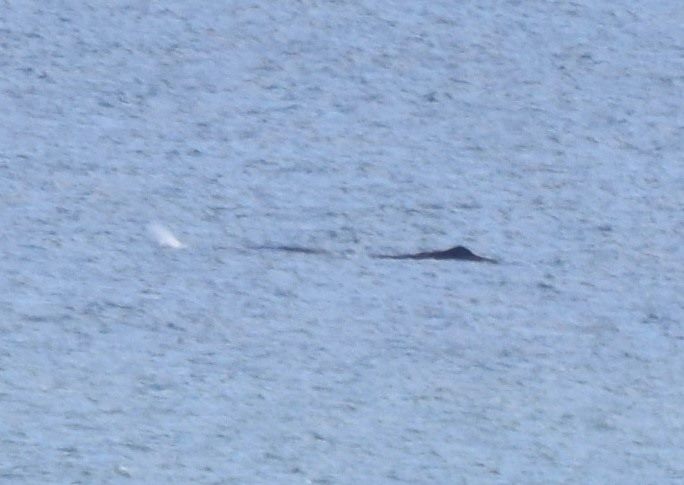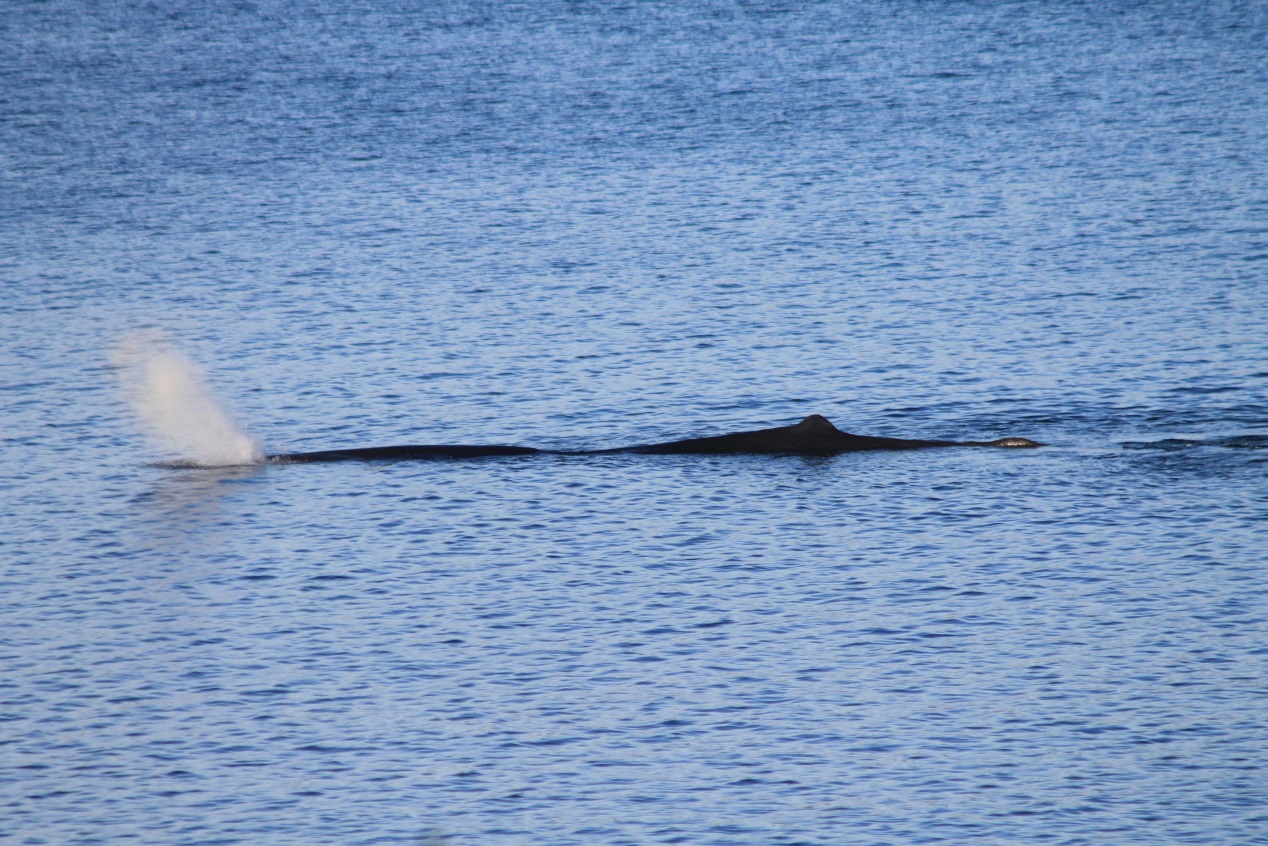One of the most famous whales of all time is Herman Melville’s Moby Dick. This fictional tale was about a sperm whale, usually found living in waters of 1,000 metres or more depth, beyond the continental shelf edge. This iconic species was thrust into the limelight earlier this year when 29 of the animals stranded on shores around the southern North Sea, including on the UK coast in Norfolk and Lincolnshire. It is thought that these animals followed a prey squid species into the North Sea and then were unable to navigate back to deeper waters.
A sighting of an unidentified whale in the Firth of Forth on Monday 4th July caused great excitement for Peter Stark who phoned in his report to Sea Watch Foundation at around 3pm yesterday. Peter happily described first being alerted to the animal by its blow (often depicted as water spouting from the head of the animal, but in fact expelled air and water vapour from these oxygen breathing mammals). Having seen a sperm whale in the Firth of Forth previously, Peter thought the animal seemed much smaller and so was unsure about its identity. However, he diligently described other features of the animal which led Sea Watch Foundation staff to narrow down the possibilities. Of particular note was the presence of a small dorsal fin (on the back of the animal) and the fact that it was seen to dive leaving its tail in the air as it went which is distinctive of a few species including humpback whale and sperm whale. Rather taken aback by their incredible close encounter, kayaker Peter along with his friend Richard Burt, were still left in some confusion over what they had seen near Inchcolm Island, despite having been paddling ‘a road’s width’ from the animal.
After reporting the sighting to Sea Watch Foundation, who collect public sightings of whales, dolphins and porpoises around the UK, Peter came across a news report in ‘The Courier’ reporting two more mystery whales in the Firth of Forth! The image in the news report clearly shows two sperm whales, with their distinctive fin shape and long straight back.
 One of the sperm whales in the Firth of Forth, reported by The Courier. Photo by Ronnie Mackie.
One of the sperm whales in the Firth of Forth, reported by The Courier. Photo by Ronnie Mackie.
Sperm whales in the Firth of Forth are not totally unheard of, Peter himself recalls ‘Moby’ the large male which stranded there in 1997, and there was a group of fourteen observed by microlight pilots in 2013. According to Sea Watch’s national database, there have been only around one hundred separate sightings in British waters in the last forty years, with the largest group on record being of 20 animals seen off Mousa in the Shetland Islands in 2007.
Ronnie Mackie, whose photograph is shown above, spoke to Sea Watch today to confirm that he saw the animals yesterday (Tuesday 5th July) from midday until about 2:30pm off the coast at Kinghorn. Ronnie and other observers definitely saw two animals and propose that there may even have been a third!
 A sperm whale. Photo by Dr Peter Evans/ Sea Watch Foundation
A sperm whale. Photo by Dr Peter Evans/ Sea Watch Foundation
There is some cause for concern over the welfare of these latest animals as they are usually at home in deep waters and if they were to head west into the firth they may not be able to navigate properly which could lead to stranding and death. “Wildlife lovers up and down the country will also be mindful of the tragic events at the beginning of 2016 when 29 sperm whales ventured too far south into the North Sea and once again stranded and died. Having said this, the public make us aware of unusual sightings all the time and more often than not these animals seemingly head off to get on with their lives as normal, so we have every hope that this will be the case for these whales in the Firth of Forth” says Kathy James, Sightings Officer for Sea Watch Foundation.
Sperm whales are amongst the largest mammal species in the world. Adult males can weigh in at up to 45 tonnes – the iconic London Routemaster double decker bus weighs less than 8 tons unladen to give some perspective!
“It would be really helpful to us if people would pay particularly attention to what they can see in the Firth of Forth at this time” continues Kathy, “Sightings can be reported on the Sea Watch Foundation website or folks can call or email their news. We need to keep a watch on the animals to see that they do head out to deeper waters and we can notify the appropriate rescue agencies should that not be the case”.
 One of two sperm whales sighted off Skye in 2014. Photo by Catherine Atkins/ Sea Watch Foundation.
One of two sperm whales sighted off Skye in 2014. Photo by Catherine Atkins/ Sea Watch Foundation.
You don’t need to be an expert to report a sighting, Sea Watch Foundation staff and volunteers will be on hand to talk you through what you saw and help you to ascertain what species you were looking at. From harbour porpoises, through dolphins up to sperm whales, any sighting that you can submit contributes to a database of UK sightings that goes back more than forty years. Using your data, Sea Watch Foundation are able to provide information on these animals to inform policy to help protect them, every record counts!
If this incredible sighting has inspired you to see what amazing wildlife can be seen in our seas, then you can take part in the National Whale & Dolphin Watch which takes places 23rd-31st July all over the UK. The Sea Watch Foundation are looking for people to head to the coast and spend an hour watching for whales, dolphins and porpoises. More information can be found on their website, or you could contact Kathy on kathy.james@seawatchfoundation.org.uk or call 01545 561227.
Find out more about the National Whale & Dolphin Watch: www.seawatchfoundation.org.uk/nwdw
Report a sighting: www.seawatchfoundation.org.uk/sightingsform
Read more about the mass sperm whale stranding early in 2016: www.seawatchfoundation.org.uk/largest-sperm-whale-stranding-ever-recorded-in-the-north-sea
























